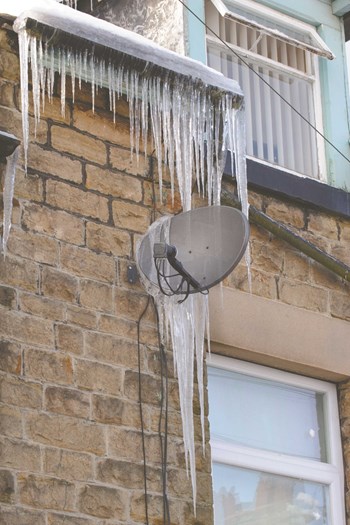
Winters these days don’t seem to be quite as brutal as they once were, due in part to the fact that in recent years, the Northeast has had more flooding and ice storms than blizzards. But pipes still freeze in the dead of night, and winter conditions still take their toll on New Jersey's HOAs. Carefully-planned landscapes can be brutalized by winter, with trees and other plantings damaged or killed by the weather. If not prepared correctly for the cold months, parking lots can become money-pits, fraught with potential liabilities as the freeze-thaw cycle turns small cracks and potholes into major problems. Heating and cooling systems can also be pushed to their limits, breaking just when the mercury hits rock bottom.
Taking steps to ensure the winter-readiness of a community should be thought of as an investment that will save potentially thousands of dollars in the short term. By avoiding costly breakdowns of systems and expensive mid-winter repairs, HOA boards and their residents will save money while skirting the inconvenience and hassle of a system-wide breakdown. They also might save themselves some worry.
Piping Hot
The life expectancy of a building’s heating-cooling system is about 20 years. But regular changes in technology have made the creation of upgraded systems far outpace the old systems’ life expectancies. Often, when a heating-cooling system fails, it already has been pushed to its limit. Then the inevitable happens and the system breaks down—usually on a sub-zero day. But such mechanical failures are not unable to be prevented. “The most important thing is to not to wait for the system to break,” says Rich Vito, vice-president of Suburban Service Corp. in Norwood, Massachusetts. “People call me all the time and say, ‘I have no heat.’ They’ve been operating with a system that’s exceeded its useful life.”
When it comes to combating harsh winter conditions, the first and most primal battle is keeping the cold out and the heat in. The key to preventing deep-winter system breakdowns is to follow a proper maintenance schedule. Regular maintenance of that system should include changing air filters annually, and also cleaning the cooling system’s coils. Such routine maintenance also can help residents save money on heating bills, says Vito. “Residue buildup can lower the efficiency of the system,” he says.
Vito recommends that a building’s heating system receive a tune-up from a qualified contractor each fall and a tune-up of the air conditioning system each spring. As with any professional consultant to a community association, such as an engineer or an attorney, a qualified contractor should be an association’s go-to person for understanding its bailiwick of heating-air conditioning systems, weatherization of that HVAC system, and replacement of the system’s parts. Disregarding the expertise of such professionals could lead an association to shoulder heavier utility bills, due to an inefficient HVAC system.
Sometimes, the age of one’s HVAC system is enough to make it a candidate for replacement. “If a system’s 10 years old, you’re likely better off replacing it,” Vito says. “Seventy percent of a building’s total energy costs are related to heating and cooling.The replacement system pays for itself in energy savings.”
Mike Ruff of Intellidyne, a Plainview, N.Y., company that manufactures energy-saving equipment for HVAC systems, agrees. "Heating systems, particularly the older systems, were basically designed and sized for the worst-case scenario," he says. "So if you think of the coldest day in January with the wind blowing, the system was designed to be able to satisfy the heat requirement for that particular day. In this part of the country, and most of the Northeast, that occurs about three to five percent of the time. The rest of the time the boiler is oversized for the application."
It's best not to wait long if you're interested in upgrading or replacing your HOA's boiler or HVAC components. Not only is there the usual demand that comes with winter, but increased energy costs have more and more people looking into these types of technologies. Ruff says it's possible that a call placed in mid-October won't yield an appointment until November or even December.
Clearly, it is unwise to operate with a system that’s at the end of its lifetime. Doing so can be a costly proposition, which might call for a short-term fix plus an eventual full system replacement. It is smarter, and cheaper, to stay ahead of such breakdowns by doing the repairs and replacements that will avoid them altogether. But before replacing its heating and air conditioning system, a condominium's management team should make sure that doing so truly makes sense. If the association hasn’t done so yet, it should have a qualified contractor conduct an energy audit of the community’s system. The audit will identify where the system’s potential savings are, if there are any to be found. The amount of potential savings, in lower utilities costs and maintenance fees, can be significant.
The Great Outdoors
It is easy to feel snug and isolated from the cold in a warm apartment, but out in the wind and snow, an HOA's landscaping can really take a beating. Winterizing the grounds of a community tends to require more physical effort than winterizing a something like a swimming pool, but the process is usually only done once in preparation for the first real chill.
According to Peter Amato, owner of Amato's Garden Center in Monmouth Junction, it's smart to prepare flowerbeds in the fall for spring blooming. The grounds of a community generally won't lose a lot of mulch during the winter, but throughout the year, mulch loss can add up enough to give the flowerbeds a tired, worn-out look. Fall is a good time to add mulch to the flowerbeds, since very little of the mulch will be lost during the winter, and because the extra mulch adds another layer of "blanket" covering dormant plants and bulbs.
At the same time in the fall, the condominium’s landscaper should do one last good cleanup of the property before the first snowfall. Cleaning up the leaves and other debris on the ground at that time will lessen the landscaper’s workload in the spring, when that debris will be water-soaked and more time-consuming to clean up. It also will limit the chance of that decaying plant matter adversely affecting vegetation in the flowerbeds. Many landscapers like to do such a year-end cleanup before Thanksgiving.
"You want to prepare for spring by planting fall bulbs, such as tulips and hyacinths," Amato says. "You could also [plant] icicle pansies, which will give your garden color in the fall and in the spring. Planting flowering kale and cabbage also will give you fall color."
Some pruning should be done to perennials prior to the ground freezing, says Amato. Generally speaking, perennial flowers should be cut back in the fall, and most ornamental grasses should also be cut back. Some people like the look of dried, dead ornamental grasses in their gardens during the winter, so this pruning is a question of preference. Others like to leave some dead perennial flowers in place during the winter so the local birds can forage from the dormant plants. However, let-it-be types, be forewarned: Tall, uncut ornamental grasses can become like leaf magnets in the winter, collecting not only leaves, but also other plant matter and even curbside trash.
For the very cautious, extra steps can be taken to protect plantings during the winter. Ornamental bushes that are susceptible to winter weather damage, such as azaleas and roses, can be covered in burlap for protection during the winter. Fall is also a good time to fertilize plants in the garden.
When it comes to landscaping in the fall, preparation is everything. Lawn care is a year-round concern, though. Amato recommends using a treatment plan in which you fertilize the lawn five times per year. "When you winterize a lawn, you can use a fertilizer with root-building feeder. That should be done by mid-October," Amato says.
A similar year-end system cleanup should be done to the sprinkler and irrigation system, which should be shut off and drained. After being drained, the lines need to be blown out with a compressor system by a qualified contractor to ensure that no water remains in the pipes. Leaving any water in the irrigation system during winter could result in fractures of sprinkler heads or cracks in the piping, which will then have to be replaced.
Winter is tough on plant life, but it's hard on animals as well. Hungry deer can be tough on a condominium’s landscaping as they search for food in the freezing weather. Many deer will eat shrubs such as arborvitae so voraciously that they will munch off all the foliage on the plant during the winter.
Replacing deer-damaged shrubs, especially if they are sizable and mature, can be quite costly—sometimes hundreds of dollars per shrub. The solution, while perhaps not the most attractive, is a lot prettier than bushes without foliage. In the fall, many landscapers now wrap a nylon mesh netting around these deer-favorite bushes, which makes it harder for the deer to eat, so they leave the plant alone.
Getting Out of the Gutter
Another important aspect of winterizing is preparation of gutters. If gutters aren't properly cleaned before the winter, they won't flow properly. And if they don't flow properly, the water that builds up in them can turn to ice, causing excess weight that can result in the gutters pulling away from the building.
"Before the winter, after the leaves fall off the trees, you must have them cleaned—that's a must," says Evan Glaser, owner of Gutter Master in Jackson.
It's also important to make sure the gutters are pitched properly. That's making sure the gutter is at the right angle—or "pitch"—so that the water flows properly to the downspout and away from the building foundation.
"We take it for granted that these are properly installed," Glaser says, "but not all companies use a level when doing a gutter installation. It's very easy to see when you're doing a cleaning whether or not the gutter is pitched properly by evidence of standing water and debris collecting more in a specific area because of that water."
Your gutter contractor should also inspect for any loose nails. If these aren't repaired, the gutter could fall away from the building, not only leaving your building gutter-less, but risking damage to property or people. Unlike other winterizing steps, you can't get your gutters cleaned in September or October and wait for the cold. You need to wait until all leaves have fallen off the trees, but get it done before the real cold weather arrives. Glaser says the ideal time to schedule an appointment is early December, but you do have to act early to get the procedural wheels in motion.
Whether you're dealing with heating systems, landscaping, or exterior features, timing is of the essence when it comes to winterizing your property. By planning smart and getting an early jump on the process, you can prepare your building or HOA for the colder months, saving your association money and hassle, and giving yourself some serious seasonal peace-of-mind.
Jonathan Barnes is a Pittsburgh freelance writer and a frequent contributor to the New Jersey Cooperator.






Leave a Comment